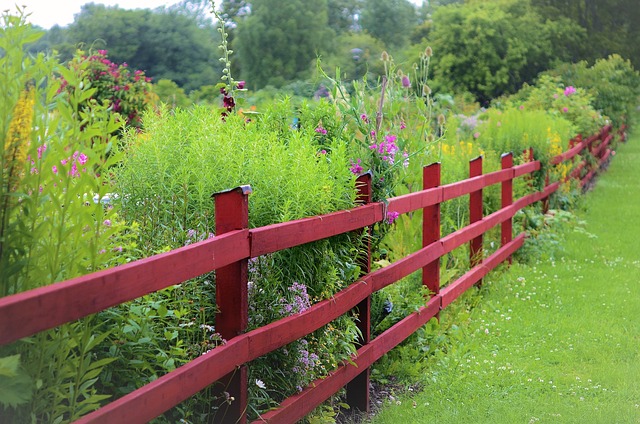For New Bedford, Massachusetts homeowners looking to enhance their outdoor spaces, DIY fence installation offers a cost-effective and rewarding project. This comprehensive guide breaks down the process into manageable steps, from understanding your fencing options specific to local properties, to digging post holes, attaching rails, and panels, and finally, maintaining your new fence for longevity. By following these detailed tips, you’ll be well on your way to creating a secure and aesthetically pleasing barrier tailored to your unique New Bedford yard.
- Understanding Your Fence Options for New Bedford Properties
- Measuring and Planning for a Successful Installation
- Gathering the Necessary Tools and Materials
- Digging and Setting Post Holes: Step-by-Step Guide
- Attaching Rails and Panels: A Visual Walkthrough
- Finishing Touches and Maintenance Tips for Longevity
Understanding Your Fence Options for New Bedford Properties
When considering fence installation in New Bedford, homeowners have a range of options to suit various needs and preferences. Wood fences are a popular choice for their natural aesthetic appeal and affordability. They require regular maintenance but can last for decades with proper care. Vinyl fencing is another durable option known for its low-maintenance requirements and resistance to rot and damage. This type of fence is also available in various styles, from traditional pickets to elegant designs mimicking wood.
Chain-link fences are ideal for security and privacy, often chosen for backyard or property boundaries. They are cost-effective and easy to install but may not offer the same visual appeal as other materials. Additionally, electric fences can be an excellent solution for large properties or those with livestock, providing a safe and effective barrier while allowing for more flexibility in landscaping.
Measuring and Planning for a Successful Installation
Before you start installing your new fence, take the time to measure and plan your project carefully. Understanding the exact dimensions of your yard or desired fence line is crucial for a successful installation. Take measurements from multiple angles to ensure accuracy, considering any curves, slopes, or unique features in your landscape. This step will help you determine the required materials, especially if you’re working with irregular shapes or needing to accommodate specific gate openings.
A well-planned fence installation saves time and money in the long run. Create a simple sketch of your yard, marking out where the fence will go, any gates or posts needed, and any potential challenges. This visual aid ensures a more straightforward process and helps you identify possible issues early on, allowing for adjustments before breaking ground.
Gathering the Necessary Tools and Materials
Before beginning your DIY fence installation project, it’s crucial to gather all the necessary tools and materials. This includes measuring tape for accurate dimensions, a level to ensure your posts are straight, post-hole digger or excavator for digging the holes, and a sledgehammer for setting the posts. Don’t forget the fence panels themselves, along with any hardware like brackets, nails, or screws specific to your chosen fencing material. Additionally, consider safety gear such as gloves, eye protection, and earplugs to protect yourself during installation.
Ensure you have a proper mix of basic tools and materials specifically tailored to your fence type. For example, if installing a wood fence, gather wooden posts, rails, and pickets suitable for the local climate. Vinyl fencing requires specific hardware designed to hold these materials securely without rusting or damaging the plastic. Properly planning and equipping yourself before starting will make the installation process smoother and more efficient.
Digging and Setting Post Holes: Step-by-Step Guide
Digging and setting post holes is a crucial step in DIY fence installation, requiring careful planning and execution. Begin by marking the fence line with stakes and string to ensure accurate positioning. Next, use a measuring tape to determine the spacing between posts—typically 6–8 feet apart—and mark these points along the fence line. Now, equip yourself with a post-hole digger or an electric drill with a hole-digging attachment. At each marked point, carefully dig a hole deep enough to accommodate about one-third of the post’s height. The holes should be wide enough for the posts to fit snugly without excessive wiggle room. Once dug, clean out any loose soil and debris from the holes to ensure stable placement.
Attaching Rails and Panels: A Visual Walkthrough
Attaching Rails and Panels is a crucial step in DIY fence installation, where you’ll join the horizontal rails to the vertical posts and then secure the picket or panel boards. Begin by aligning the rail with the post, ensuring they’re level and properly spaced. Next, use your chosen method of attachment – whether it’s brackets, nails, or screws – to fasten the rail firmly in place. Visualize each step: mark where the holes should go, make pilot holes if necessary, and ensure all hardware is secure before moving on.
Once the rails are securely attached, repeat the process for each panel by aligning and attaching them to both the rails and posts. This visual walkthrough helps you understand the physical layout of your fence and ensures a sturdy structure as you work through each section.
Finishing Touches and Maintenance Tips for Longevity
Once your fence is fully installed, it’s time to focus on finishing touches that will enhance its beauty and longevity. Consider adding a coat of high-quality sealent or paint to protect the fence from the elements and give it a polished look. Regular cleaning with mild soap and water can remove dirt and debris, preventing buildup.
For long-term maintenance, inspect your fence regularly for signs of damage or wear. Repair any broken boards or posts promptly using suitable replacement parts. Keep the area around the fence clear of overhanging branches and other obstructions that could cause damage or hinder access for future maintenance. Regular trimming and pruning will also ensure your fence remains aesthetically pleasing and well-maintained.
